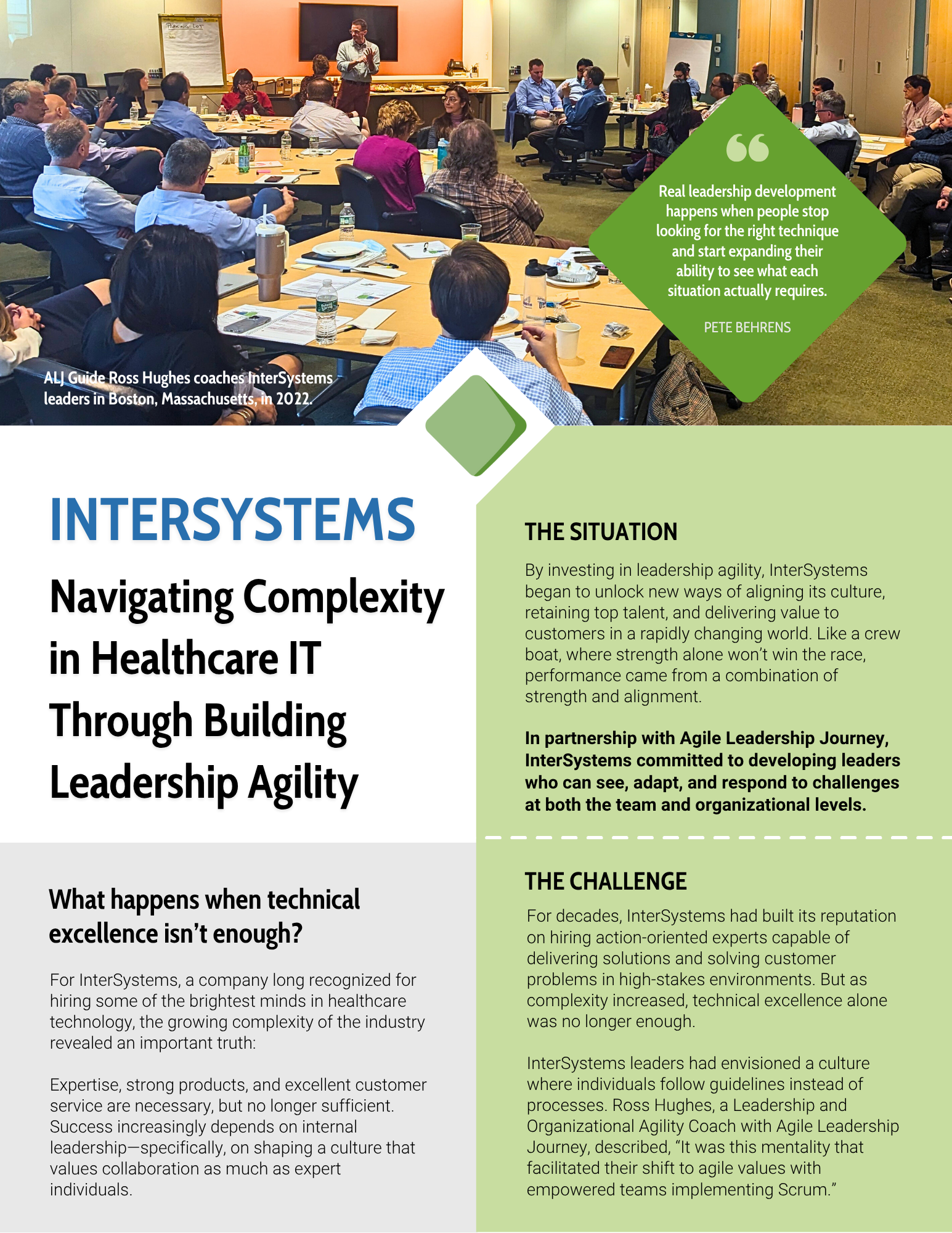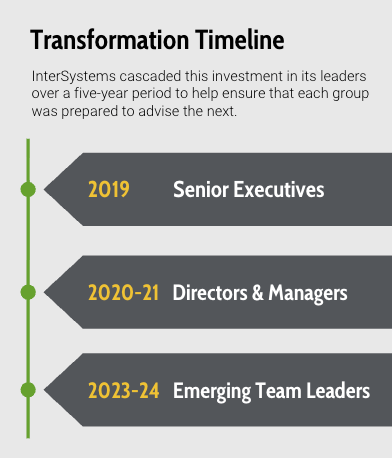ALJ Case Study | InterSystems: Navigating Complexity in Healthcare IT Through Building Leadership Agility
What happens when technical excellence isn’t enough?
For InterSystems, a company long recognized for hiring some of the brightest minds in healthcare technology, the growing complexity of the industry revealed an important truth:
Expertise, strong products, and excellent customer service are necessary, but no longer sufficient. Success increasingly depends on internal leadership—specifically, on shaping a culture that values collaboration as much as expert individuals.
By investing in leadership agility, InterSystems began to unlock new ways of aligning its culture, retaining top talent, and delivering value to customers in a rapidly changing world. Like a crew boat, where strength alone won’t win the race, performance came from the combination of strength and alignment.
In partnership with Agile Leadership Journey, InterSystems committed to developing leaders who can see, adapt, and respond to challenges at both the team and organizational levels.
The Challenge: Beyond Technical Excellence
InterSystems' Inner Struggles
- Collaboration bottlenecks: Highly talented individuals worked well independently, but struggled to align across teams. Bottlenecks emerged as coordination demands grew.
- Talent retention: With a highly selective hiring process and significant investment in employee development, the company sought to reinforce its retention efforts and safeguard against the challenges of replacing top talent.
- Slowed product cycles: Release timelines were increasingly weighed down by cross-team dependencies and coordination challenges.
- Uneven leadership capability: Many managers excelled at directing and delivering, but fewer were skilled in guiding, aligning, and inspiring.
InterSystems leaders had envisioned a culture where individuals follow guidelines instead of processes. Ross Hughes, a Leadership and Organizational Agility Coach with Agile Leadership Journey, described, “It was this mentality that facilitated their shift to agile values with empowered teams implementing Scrum.”
While this improved some product delivery challenges, it wasn’t enough to address issues that would require a different leadership approach to resolve.
“Many organizations try to solve human system problems with technical solutions,” explains Pete Behrens, Founder and CEO of Agile Leadership Journey. “But sustainable transformation requires leaders who can navigate the space between structure and flexibility, between individual excellence and collective impact.”
The Approach: Leadership Through Three Lenses
Rather than delivering a predetermined solution, Hughes and Behrens guided InterSystems leaders around the globe—from executives through individual contributors—through a leadership evolution that broadened their perspective, shifted their time horizons, and deepened their self-awareness.
The transformation wasn't about adopting new tools or processes; it was about developing the internal capacity to navigate complexity with greater clarity.
“Real leadership development happens when people stop looking for the right technique and start expanding their ability to see what each situation actually requires,” notes Pete Behrens.
Continue reading below...

Download the Complete Case Study
1. Broadening the System Perspective: Reimagining Structures
Organizational structures can unintentionally limit human capacity. Siloed divisions and rigid roles often slow progress. InterSystems was no different—until 2019, when Head of Global Healthcare Solutions Don Woodlock ran an experiment to shift his division’s “human system.”
By replacing siloed, hierarchical structures with empowered, cross-functional teams, leaders removed internal information barriers and delegated more decision authority. This improved collective intelligence and decision-making—aligning the human system more closely with the company’s solution system.
2. A More Adaptive Time Horizon: Balancing Short- and Long-Term Goals

Like many organizations, InterSystems struggled to navigate urgent disruptions alongside long-term strategy. Historically, product updates were released annually.
As complexity grew, delays mounted. By shifting from predictive planning to empirical, iterative cycles, the company increased both release predictability and value delivery.
Yet the real differentiator wasn’t just the adoption of agile practices—it was the development of leaders capable of stewarding both short-term delivery and long-term organizational change.
Woodlock, drawing from the leadership development he received while at GE Healthcare, believed that management alone couldn’t solve the hardest problems. True leadership meant guiding teams into uncharted territory—requiring more leaders to step forward.
3. A Deeper Self-Awareness: Building Adaptive Leaders
Through Agile Leadership Journey’s engagement, InterSystems leaders reflected on their own styles and learned to adapt them to the needs of the moment. Instead of defaulting to “providing answers,” leaders began balancing directive decisions with curiosity-driven coaching, enabling solutions to emerge organically from teams.
As Woodlock explained, “Improvement doesn’t just come from the top.” This mindset led to intentional investment in leaders at every level: senior executives in 2019, directors and managers in 2020 and 2021, and then, emerging team leaders in 2023 and 2024.
The Results: Cultural & Organizational Shifts
The transformation at InterSystems demonstrates how leadership development directly drives organizational performance. Rather than treating people development and business results as separate objectives, the company discovered they were fundamentally connected. By prioritizing leadership development, InterSystems began to see measurable improvements in outcomes amongst employees, customers, and business.
The most compelling results InterSystems reported include:
- Lower attrition: Turnover dropped even further below industry averages. Leaders attributed this to employees feeling invested in, supported, and given opportunities to learn and grow.
- Stronger organizational agility: When COVID-19 disrupted demand for a new product, leaders and teams adapted quickly to changing market needs.

For Woodlock, this proved that “the word agile means something”—that it’s not just a process, but a mindset and leadership response.
ALJ Guide Ross Hughes, notes, “The real measure isn’t just improved metrics. It’s whether leaders can sustain this agility when the next disruption arrives. InterSystems proved they could adapt their leadership response, not just their processes.”
The Path Forward
InterSystems experience reveals an important truth for technology leaders: in an industry built on solving complex problems, the most persistent challenges are often human ones.
“What we see is that this truth applies universally for most complex organizational problems—really regardless of industry,” Hughes reveals. By developing leaders who could see systems more clearly, balance time horizons and competing priorities more dynamically, and respond to uncertainty with greater self-awareness, the company didn't just improve its metrics—it built the internal capacity to thrive amid whatever changes come next.”
The journey continues, but InterSystems has proven that when organizations invest in developing leadership agility at all levels, they create something more valuable than improved processes: they build resilience that becomes part of their competitive advantage.
Will your organization's success story be ALJ's next case study?
InterSystems' story isn't about software or structure—it's about what happens when leaders commit to rethinking how value is delivered.
If your organization is facing stalled growth, siloed teams, or cultural tension, Agile Leadership Journey can help.






